A sculpture made of 2,800 empty beer bottles and wood from the river tamarind tree is to feature at this year’s Taiwan Lantern Festival, which begins on Tuesday next week in Pingtung County’s Dapeng Bay (大鵬灣).
The sculpture, which is 3m tall and 5m wide, lights up at night and is supported by a steel frame.
Each bottle is signed by a resident of Pingtung’s Hengchun Township (恆春), where the artist, Yang Tsung-hsun (楊宗熏), is based.
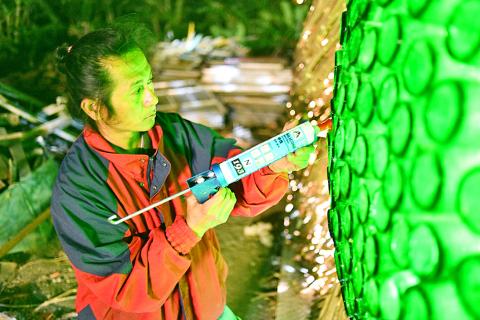
Photo: Tsai Tsung-hsien, Taipei Times
The sphere shape formed by the beer bottles is like a gigantic beehive, Yang said.
When the sculpture is lit up at night, it looks like a giant guangmingdeng (光明燈) — a small lamp lit by Taoists before Lunar New Year for good fortune in the coming year, he said.
The sculpture, which was commissioned by the Pingtung Cultural Affairs Department, is to also be exhibited in Hengchun Township after the festival ends, he said.
Born in Hengchun Township’s Dehe Borough (德和), Yang often uses the river tamarind in his work.
His works have previously helped Dehe Borough win a Yuan Ye Award for architectural landscape.
He decided to use the green bottles that Taiwan Tobacco & Liquor Corp uses for its Gold Medal Taiwan Beer after discussing the idea with Danish artists Rikke Juellund and Mikael Fock, Yang said.
He had been worried that it would be difficult to gather the number of empty bottles he needed within such a short period of time, but he was able to collect the empty bottles within a few days, he said.
The company should commend him or even “adopt” the sculpture, he added.
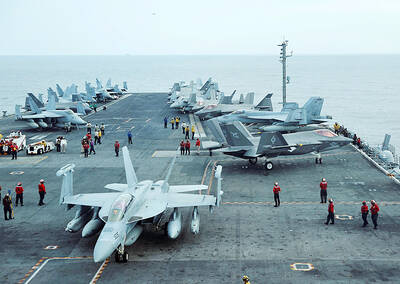
China might accelerate its strategic actions toward Taiwan, the South China Sea and across the first island chain, after the US officially entered a military conflict with Iran, as Beijing would perceive Washington as incapable of fighting a two-front war, a military expert said yesterday. The US’ ongoing conflict with Iran is not merely an act of retaliation or a “delaying tactic,” but a strategic military campaign aimed at dismantling Tehran’s nuclear capabilities and reshaping the regional order in the Middle East, said National Defense University distinguished adjunct lecturer Holmes Liao (廖宏祥), former McDonnell Douglas Aerospace representative in Taiwan. If
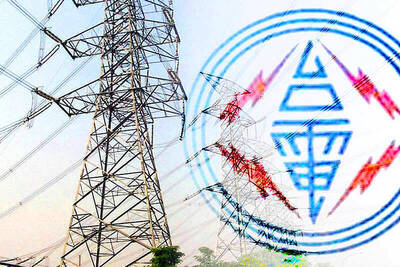
TO BE APPEALED: The environment ministry said coal reduction goals had to be reached within two months, which was against the principle of legitimate expectation The Taipei High Administrative Court on Thursday ruled in favor of the Taichung Environmental Protection Bureau in its administrative litigation against the Ministry of Environment for the rescission of a NT$18 million fine (US$609,570) imposed by the bureau on the Taichung Power Plant in 2019 for alleged excess coal power generation. The bureau in November 2019 revised what it said was a “slip of the pen” in the text of the operating permit granted to the plant — which is run by Taiwan Power Co (Taipower) — in October 2017. The permit originally read: “reduce coal use by 40 percent from Jan.
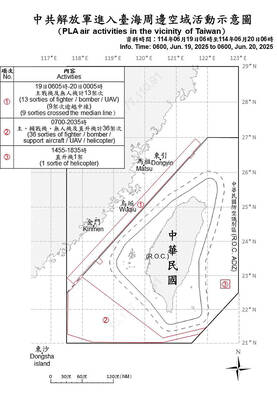
‘SPEY’ REACTION: Beijing said its Eastern Theater Command ‘organized troops to monitor and guard the entire process’ of a Taiwan Strait transit China sent 74 warplanes toward Taiwan between late Thursday and early yesterday, 61 of which crossed the median line in the Taiwan Strait. It was not clear why so many planes were scrambled, said the Ministry of National Defense, which tabulated the flights. The aircraft were sent in two separate tranches, the ministry said. The Ministry of Foreign Affairs on Thursday “confirmed and welcomed” a transit by the British Royal Navy’s HMS Spey, a River-class offshore patrol vessel, through the Taiwan Strait a day earlier. The ship’s transit “once again [reaffirmed the Strait’s] status as international waters,” the foreign ministry said. “Such transits by
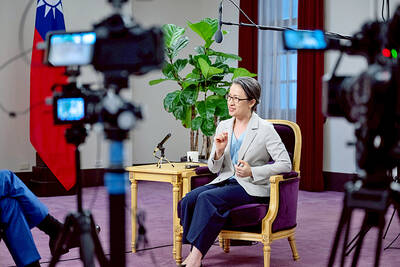
Taiwan is doing everything it can to prevent a military conflict with China, including building up asymmetric defense capabilities and fortifying public resilience, Vice President Hsiao Bi-khim (蕭美琴) said in a recent interview. “Everything we are doing is to prevent a conflict from happening, whether it is 2027 or before that or beyond that,” Hsiao told American podcaster Shawn Ryan of the Shawn Ryan Show. She was referring to a timeline cited by several US military and intelligence officials, who said Chinese President Xi Jinping (習近平) had instructed the Chinese People’s Liberation Army to be ready to take military action against Taiwan